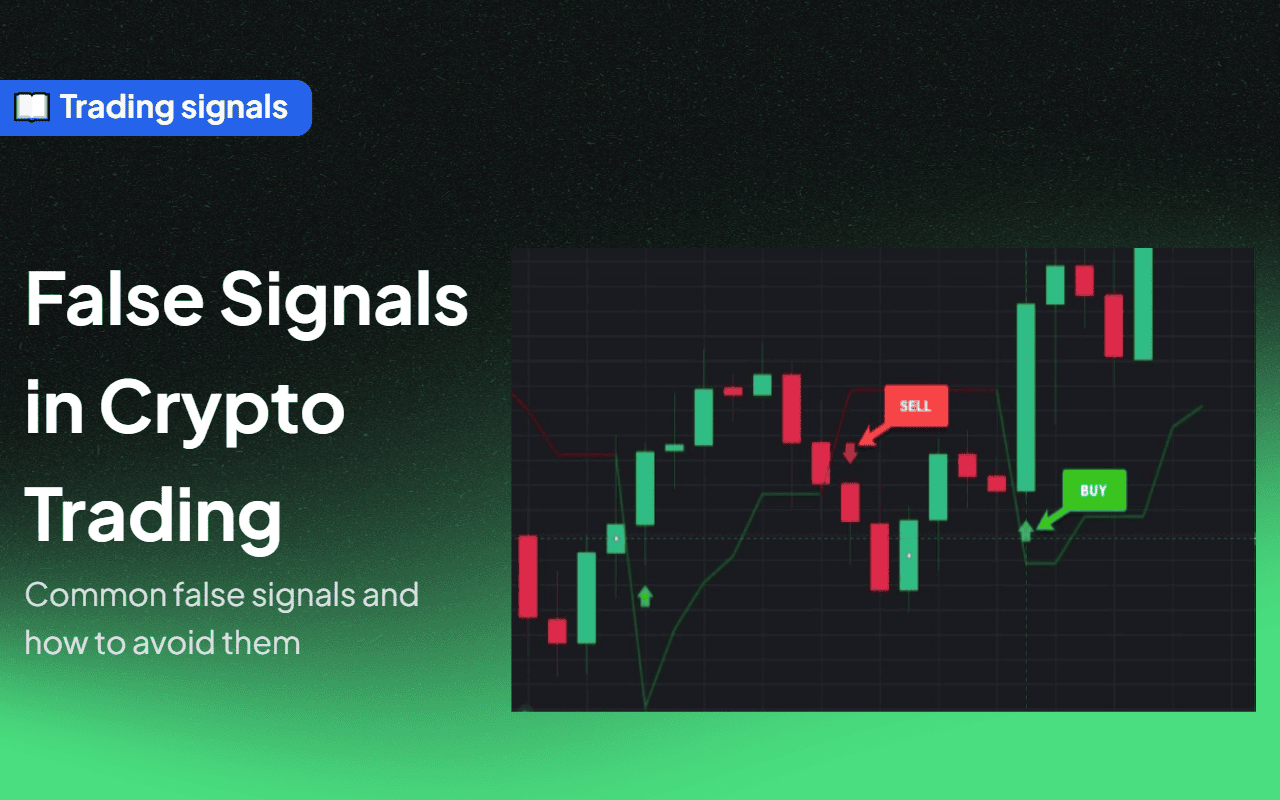.svg)
.svg)
.svg)
.svg)
.svg)
.svg)
.svg)
.svg)
.svg)
.svg)
.svg)
.svg)
.svg)

What Are False Signals in Crypto Trading and How to Avoid Them
Even the most experienced crypto traders can sometimes fall victim to false signals. Apart from manifesting in various forms, false signals in crypto trading can significantly misguide you and lead to costly losses.
Read below to learn how to identify and outsmart them, so you won’t miss out on opportunities or make wrong decisions.
Types of False Signals in Crypto Trading
False signals in crypto trading are misleading indicators that suggest a certain trade should be made, but in reality, the opposite happens. And you end up in a loss. These signals can occur for various reasons, like misinterpretation of data, faulty indicators, or market manipulation. They can also happen in any market condition, whether bullish or bearish, and across different time frames and asset classes.
The most common false signals you can encounter in crypto trading are fake breakouts, fake reversals, or deceptive patterns.
Fake Breakdowns
A fake breakdown is a false signal that occurs when a cryptocurrency’s price breaks below or above a significant support or resistance level, but then quickly returns to its previous range.
A fake breakdown can trick crypto traders into thinking that a trend has ended or that an existing trend has weakened.
For example, if Ethereum’s price breaks below a support level, you may believe that it’ll continue to fall and decide to sell your Ethereum. However, if the breakdown is fake, the price may soon rise back above the support level and cause losses for having sold at the lower price.
Fake Reversals
A fake reversal is a false signal that occurs when a cryptocurrency’s price temporarily changes its direction but then resumes its original direction. Failing to identify a fake reversal could make you think that a trend has reversed or that an existing trend has changed its momentum.
For example, if Litecoin's price is in an uptrend, but then drops sharply for a short period, you might assume that it has entered a downtrend and sell your Litecoin.
However, if the reversal is fake, the price may soon bounce back and continue its uptrend and cause losses because you sold at the lower price.
Deceptive Price Patterns
Some chart formations may mislead you into believing that a cryptocurrency’s price will move in a certain direction, when in fact it’ll do the opposite.
For instance, the Head and Shoulders pattern is considered complete when the price breaks below the neckline, which connects the lows of the two shoulders. Similarly, the Double Top pattern is complete when the price breaks below the support level that connects the lows of the two peaks. However, in both cases, sometimes the price may bounce back above the neckline after breaking it, creating a false reversal signal.
What Causes False Signals?
Some common causes that trigger false signals include:
- market manipulation: as cryptocurrencies are relatively young, the absence of stringent regulations can make them susceptible to market manipulation; thus, whales or large traders can influence prices to trigger false signals.
For example, they may use pump-and-dump schemes, spoofing, wash trading, or other techniques to create artificial price movements or volumes that don’t reflect the true market sentiment.
- technical glitches: technical glitches or errors, like software bugs or data issues, can result in false price information; this could happen even when adding and analyzing technical indicators on a price chart.
- overlooking market conditions: you may misunderstand or misread the data provided by technical indicators or chart patterns; for example, you might ignore the context of the market condition or the time frame you’re using, or overlook other factors that may influence the price action.
- liquidity issues: low liquidity in certain assets can amplify the impact of small trades, leading to deceptive price movements.
- news and sentiment: news events and market sentiment can create sudden price spikes or crashes, often leading to false signals that aren’t sustainable in the long run.
How to Stay Away from False Signals
Some helpful strategies that can help you identify and manage false signals effectively include:
- using multiple indicators: rely on a combination of technical indicators, like Moving Averages, Relative Strength Index (RSI), and MACD, to validate price movements and confirm trends;
- applying risk management: implement risk management strategies, including setting stop-loss orders, so you can limit potential losses when false signals lead to unfavorable outcomes;
- staying informed: keep abreast of the latest news and developments in the cryptocurrency space to gauge the impact of external factors on market movements;
- backtesting your strategy: backtest how a trading strategy would perform using historical data; this will help you evaluate the effectiveness and profitability of your trading approach before risking real money in the market;
*Pro tip: you can use Altrady’s paper trading feature where you can use virtual coins to replicate your trading and test out ideas.
- controlling your emotions: avoid making impulsive decisions based on emotions, as they can lead to falling victim to false signals.
Bottom Line
False signals in crypto trading are an ever-present challenge, but with the right knowledge and strategies, you can steer clear of their disturbing nature and minimize their impact.
The key lies in understanding the market, using a combination of technical indicators and backtesting tools.






























